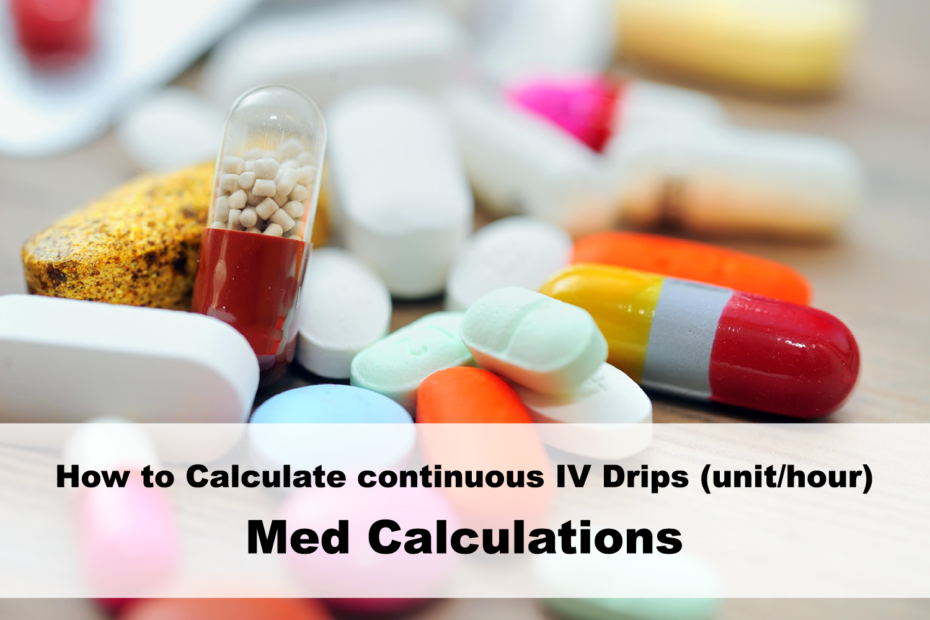In the first two installments of this blog series we reviewed common drug calculation methods such as the universal formula (desired over have method) and dimensional analysis. How to Convert units/hr to mL/hr? In Part 3, we’ll take a closer look at dimensional analysis and how to use it to calculate continuous intravenous (IV) drips, beginning with units per hour (units/hr).
After reading this blog you are able to calculate:
- Units/hr to ml/hr
- mg/hr to ml/hr
- mcg/hr to ml/hr
- ml/hr to Units/hr
- ml/hr to mg/hr
- ml/hr to mcg/hr
Intravenous Drips: How to Convert units/hr to mL/hr
Now let’s use dimensional analysis to figure out continuous IV infusions. Let’s begin with a common infusion of heparin.
Example 1: Administer heparin 500 units per hour continuous IV. Pharmacy supplies the heparin with a concentration of 20,000 units in 500 mL D5W (40 units/mL). At what rate should you set the IV pump?
Step 1: What label is needed? We want to know the rate on the IV pump (mL/hr) and this is placed on the left side of the equation.

Step 2: Place the same label in the numerator on the right side of the equation. The concentration of the heparin drip is 40 units/mL. Invert so that mL is on top.

Step 3: Alternate labels in numerator and denominator so labels cancel out. The desired dose is 500 units/hour.

Step 4: Multiply numerators, multiply denominators, then divide numerator by denominator.

Answer: 12.5 mL/hr
Most institutions utilize infusion pumps that can be programmed to the tenth or hundredth decimal place. If your institution does not have infusion pumps with this capability, you may need to round to the nearest whole number.
IV Drips: How to Convert units/hr to mL/hr
Next, let’s reverse the process using dimensional analysis. In the next example, you know the IV hourly rate (mL/hr) of the infusion but you need to verify the dose.
Example 2: You receive shift report that your patient is on a heparin drip and you want to verify the dose that that patient is receiving. The pump is running at 12.5 mL/hour. The label on the bottle reads 20,000 units in 500 mL D5W (40 units/mL). How many units/hour is the patient receiving?
Step 1: We want to know how many units of heparin the patient is receiving per hour. This is placed on the left side of the equation.

Step 2: Place the same label in the numerator on the right side of the equation. The concentration of the heparin drip is 40 units/mL.

Step 3: Alternate labels in numerator and denominator so labels cancel out. The current drip rate is 12.5 mL/hour.

Step 4: Multiply numerators, then multiply denominators.

Answer: 500 units/hr
This is consistent with the shift report.
Click Here for Continuous IV Drips Calculator which allows you to calculate:
- Units/hr to ml/hr Calculator
- mg/hr into ml/hr Calculator
- mcg/hr to ml/hr Calculator
- mcg/min to ml/hr calculator
- units/min to ml/hr calculator
- mg/min to ml/hr calculator
Remember These Tips:
- Check that your answer makes sense clinically.
- Double check your work.
- Have a colleague or pharmacist check your work.
- Know general therapeutic drug doses for commonly administered medications
I hope this review has been helpful. Next, we will review continuous IV infusions for drugs delivered in micrograms per minute (mcg/min) using dimensional analysis.

Pingback: How to Calculate IV Drips (mcg/kg/minute) | Med Calculations - Medicalculators